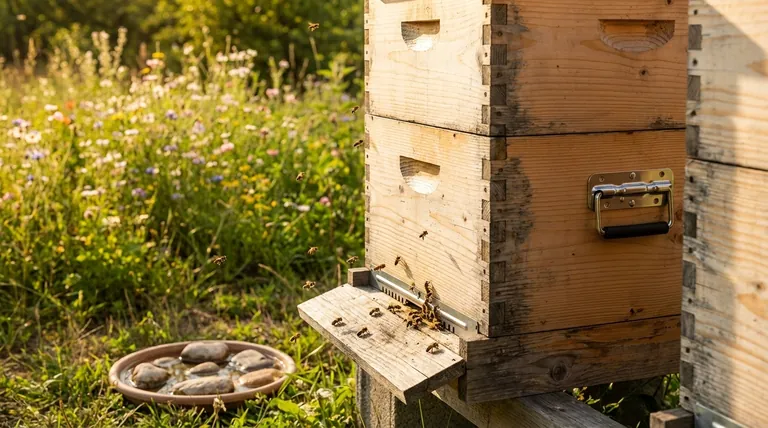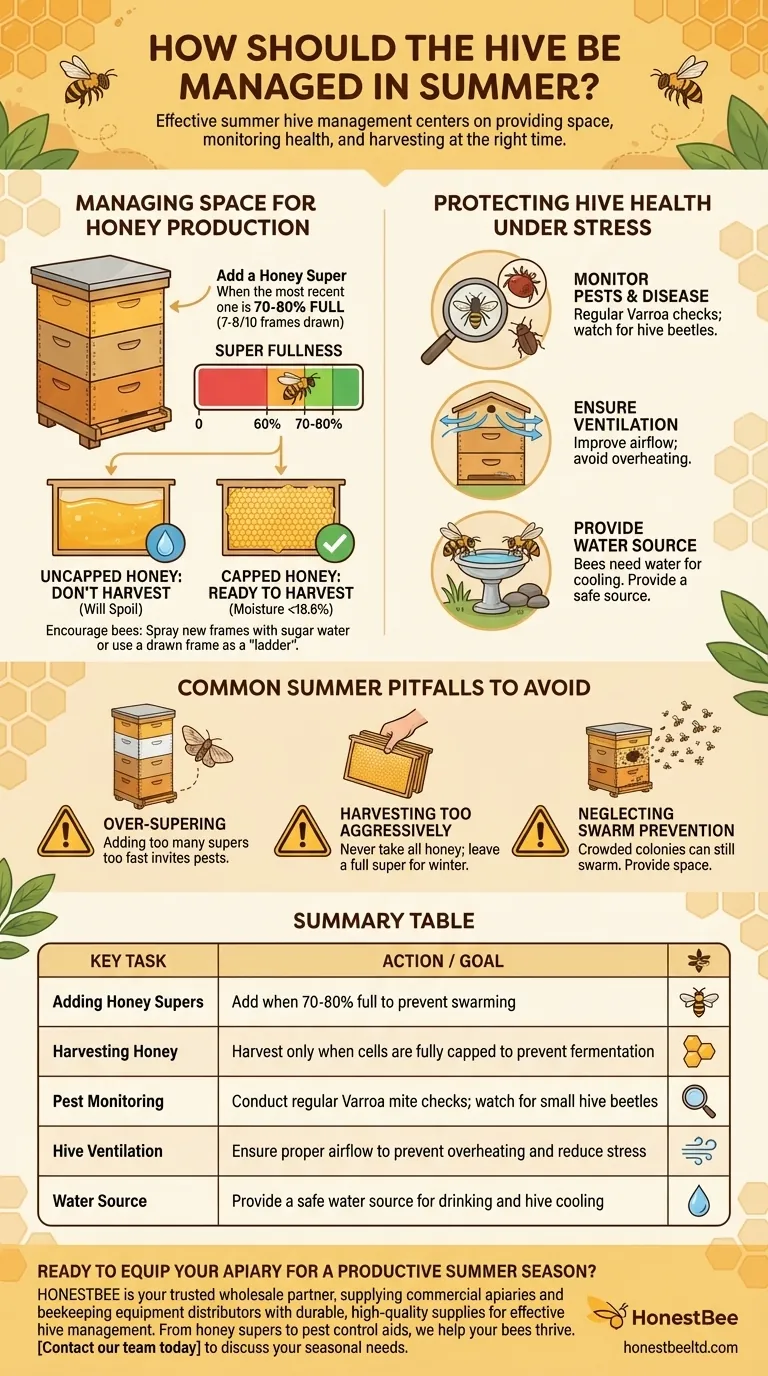Effective summer hive management centers on a simple loop: providing space for honey storage, monitoring the colony's health during its peak, and harvesting the surplus at the right time. For hives that are strong and at least three boxes high, this means adding your honey super to the very top once the bees begin storing nectar and building comb in the uppermost box.
The core challenge of summer is balancing the desire for a large honey harvest with the colony's need to remain populous, healthy, and well-provisioned for the seasons ahead. Your role is to facilitate their work, not hinder it.

The Primary Goal: Managing Space for Honey Production
In summer, a healthy colony with a productive queen can expand at an explosive rate. Your main job is to ensure they never run out of space, which can trigger a swarm and drastically reduce your honey crop.
When to Add a Honey Super
The most common rule is to add a new honey super when the most recently added one is 70-80% full. This means the bees have drawn out the comb and are actively working on 7 or 8 out of every 10 frames.
Adding a super too early forces the bees to patrol and heat a larger, emptier space. Adding it too late can create a "honey-bound" brood nest, where the queen runs out of room to lay eggs, and may trigger the colony to swarm.
Encouraging Bees to Use New Frames
Especially with new plastic foundation, like those in a Flow Hive, bees can be hesitant to start working. You can encourage them by spraying the new frames lightly with sugar water.
Another effective method is to place a frame of drawn-out comb from another box into the new super, which acts as a "ladder" and invites them upward to begin work.
Knowing When to Harvest
Honey is ready for harvest only when the bees have capped the cells with wax. This is your signal that they have fanned the nectar, reduced its moisture content to the correct level (below 18.6%), and sealed it for long-term storage.
Harvesting "uncapped" or "wet" honey will result in a product that is likely to ferment and spoil. Once a frame is fully capped, you can extract the honey. After extraction, the frames are reset for the bees to fill again.
Protecting the Hive's Health Under Stress
Summer is a time of peak population and peak stress. Intense heat, resource competition, and thriving pest populations require your close attention.
Monitoring for Pests and Disease
Varroa mite populations can explode during the summer as the bee population peaks. Regular mite checks are non-negotiable. A high mite load in late summer can decimate the "winter bees" that are critical for the colony's survival.
Also, keep an eye out for signs of other diseases or pests like small hive beetles, which thrive in the summer heat.
Ensuring Proper Ventilation
A crowded hive on a hot summer day can easily overheat. This stresses the colony and forces many bees to stop foraging just to fan the hive and keep the brood cool.
Ensure the hive has a well-ventilated lid and consider propping the inner cover up slightly to create an upper entrance, which can dramatically improve airflow.
Providing a Water Source
Bees use a tremendous amount of water in the summer, both for drinking and for evaporative cooling inside the hive.
If there isn't a natural water source (pond, stream) nearby, providing one can significantly help your bees. A birdbath with stones or a shallow dish with marbles allows them to drink safely without drowning.
Common Summer Pitfalls to Avoid
Even experienced beekeepers can make missteps during the busiest season. Awareness of these common issues is the first step to avoiding them.
Over-Supering the Hive
While giving bees space is critical, adding too many supers at once can be counterproductive. The bees will struggle to patrol and defend the vast empty space, making it an attractive target for pests like wax moths and small hive beetles.
Harvesting Too Aggressively
Never take all the honey. A good rule of thumb is to leave the bees with an entire super of honey for themselves, especially as you approach the end of the main nectar flow. This is their insurance policy for winter and poor weather.
Neglecting Swarm Prevention
While the primary swarm season is spring, strong colonies can still swarm in early summer if they become overcrowded. Continuing to provide adequate space is the best prevention method.
How to Adapt Your Summer Strategy
Your approach should align with your primary objective for the hive.
- If your primary focus is maximizing honey yield: Be aggressive with supering, adding a new box as soon as the previous one is 70-80% full, and be prepared to harvest multiple times.
- If your primary focus is colony health and growth: Prioritize leaving the bees with ample resources, be more conservative with harvesting, and focus intently on integrated pest management to ensure a strong winter population.
- If your primary focus is a balanced, low-stress approach: Add supers as needed, plan for a single, substantial harvest in late summer, and ensure the hive is well-ventilated and pest-free throughout the season.
Ultimately, your role in summer is to be an attentive partner to your bees, providing the resources they need to capitalize on nature's abundance.
Summary Table:
| Key Summer Management Task | Action / Goal |
|---|---|
| Adding Honey Supers | Add when the current super is 70-80% full to prevent swarming. |
| Harvesting Honey | Harvest only when cells are fully capped to prevent fermentation. |
| Pest Monitoring | Conduct regular Varroa mite checks; watch for small hive beetles. |
| Hive Ventilation | Ensure proper airflow to prevent overheating and reduce stress. |
| Water Source | Provide a safe water source for drinking and hive cooling. |
Ready to equip your apiary for a productive summer season?
HONESTBEE is your trusted wholesale partner, supplying commercial apiaries and beekeeping equipment distributors with the durable, high-quality supplies needed for effective hive management. From honey supers and frames to ventilation tools and pest control aids, we help you support your bees' peak productivity.
Contact our team today to discuss your seasonal needs and explore our wholesale catalog. Let's ensure your colonies thrive.
Visual Guide

Related Products
- Premium Comfort Grip Spring-Loaded Hive Handles
- Professional Drop-Style Hive Handles for Beekeeping
- Professional Grade Foldable Beehive Handles
- Black Plastic Beetle Barn Hive Beetle Trap for Beehives
- Heavy-Duty Stainless Steel Clip-On Frame Perch
People Also Ask
- Why is it important to clean and sanitize beekeeping equipment before storage? Protect Your Apiary Investment
- How do you keep bugs out of bee hives? Build a Pest-Proof Fortress for Your Colony
- How should you secure the bees before moving them? A Guide to Safe, Stress-Free Hive Transport
- What makes polyurethane foam environmentally friendly? The Surprising Benefits of a Durable, Inert Material
- What precautions should be taken during the actual move of hives? A Guide to Safe Beehive Relocation



















